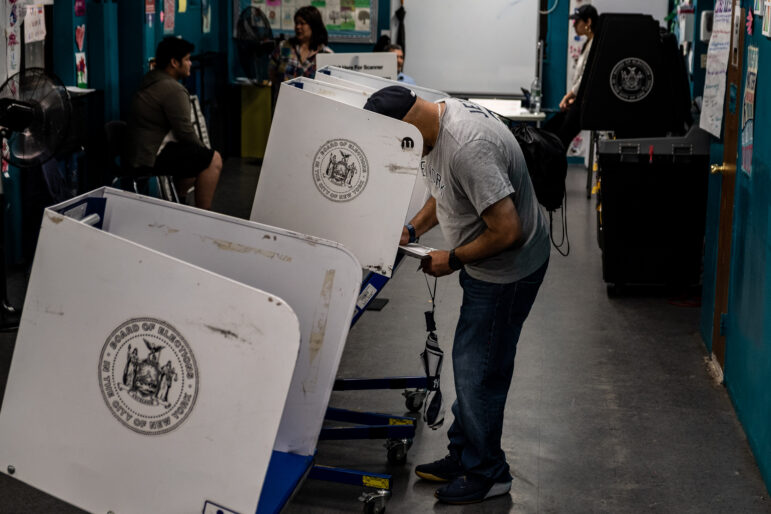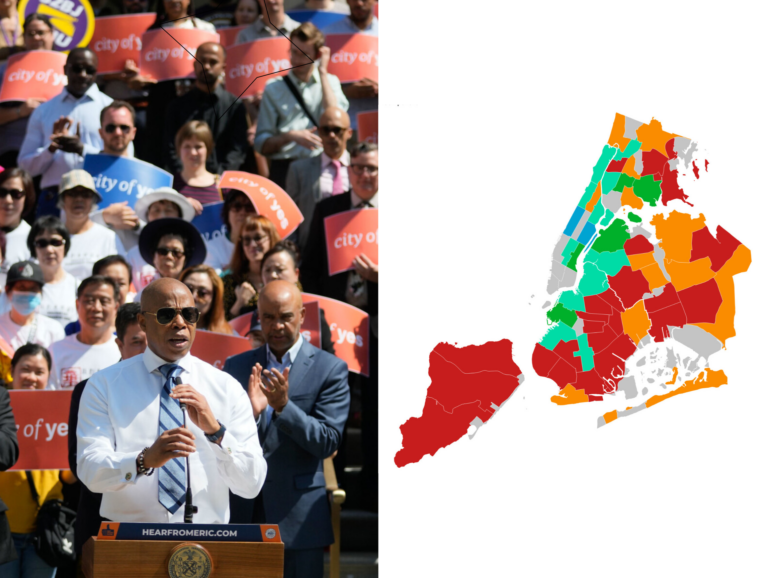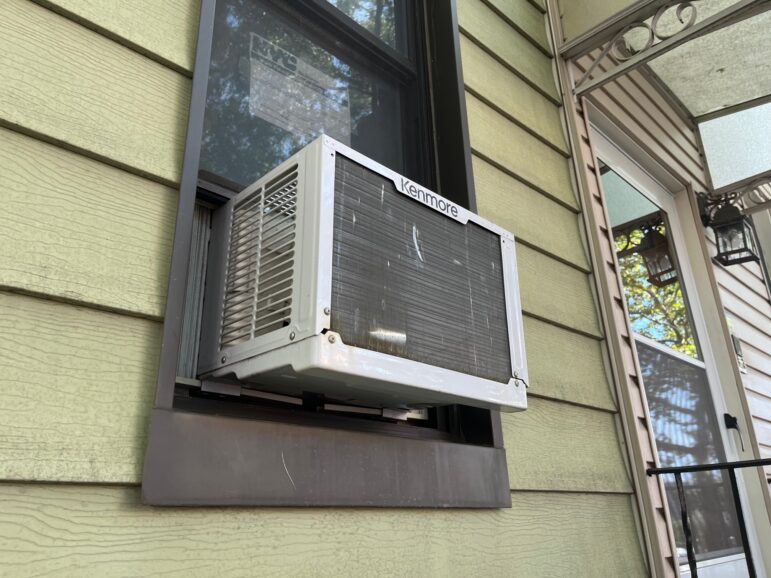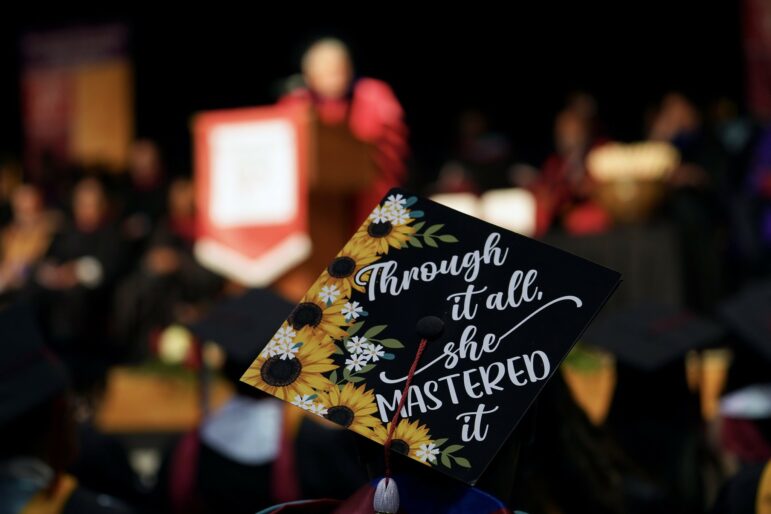
Photo by: Marc Fader
New housing in East New York has put housing ownership within reach for hundreds of working-class families.
Eighty years ago, the land along East New York’s southeastern border, now known as Spring Creek, was where the city came to an end.
When people fleeing the tenements built houses in an area of East New York called New Lots, when they grew vegetables on the empty land next door and watched government paving crews lay down Linden Boulevard, Spring Creek was the land beyond that. It was the scrubby turf where their teenagers played sandlot baseball, the forbidding tall grass where the ill-intentioned stashed stolen cars, or worse.
It was all this, in short, because Spring Creek was a part of Brooklyn that nobody wanted—well past the end of any subway line and miles from the Manhattan skyscrapers that were sometimes visible in the distance. But over the years, the city spread out. As East New York filled up, land in Spring Creek was there, cheap and available, to handle the overflow. In one corner, a street grid developed around Flatlands Avenue. Public housing projects followed in the 1950s, and in 1974 came the vast subsidized rental complex at Starrett City. By the Belt Parkway, in 2002, came the Gateway Center Mall.
Large swaths, though, remained untouched. And in the city’s lowest years, when drugs and guns threatened to drag poor places underwater, it seemed that the fringes of Spring Creek might stay empty forever. After all, the rest of East New York, long a bastion for the working class, itself felt hollowed out. By the 1980s, the neighborhood’s residents picked their way home through blocks of vacant buildings that were burned out, stripped or simply left to crumble.
This is the East New York that lingers in the city’s imagination. As Brooklyn surged over the past decade, as Flatbush Avenue and Fourth Avenue saw construction of tower after tower, and as former factories of all kinds (the Toy Factory Lofts, the Chocolate Factory condos) filled with bright-eyed young artists and professionals—somehow the image of East New York never changed in the public mind. As far as it was from Manhattan, it was further still—in the collective imagination anyway—from the new Brooklyn.
But something new was happening there too—a dozen L-train stops past Williamsburg’s most intrepid hipsters. East New York, a half-century ago a neighborhood of immigrants and blue-collar commuters, was growing back into just that again. Since the early 1980s, on thousands of acres of vacant land, groups like East Brooklyn Congregations have built more than 3,000 new affordable houses for local buyers. The empty core of East New York has, essentially, filled back up.
“It’s all been rebuilt,” says Michael Gecan, co-director of the Industrial Areas Foundation. “And not for the artists, God bless ’em, or the students or tourists or stockbrokers. It’s all been built for the corrections officers and the health workers and the city workers, almost all Hispanic and black buyers and renters.”
Taken as a whole, Gecan argues, the physical rebuilding of eastern Brooklyn’s blighted neighborhoods ranks as one of the great public works projects of the past century. “And it’s not happening in the cool neighborhoods,” he says. “It’s in what used to be the uncool neighborhoods.”
All across uncool Brooklyn, in fact, neighborhoods have been regenerating. Some, like East New York and Bushwick, have come a long way back from disaster. Meanwhile, other neighborhoods far from Brooklyn’s trendier zones, like middle-class Bensonhurst and Bay Ridge, have maintained their prosperity while undergoing dramatic yet largely peaceful ethnic shifts.
These places, and neighborhoods like them, are not the Brooklyn for which David Beckham’s child is named. They aren’t the Brooklyn electrified by upwardly mobile newcomers or abandoned by industry, but they are where most of the borough’s 2.6 million residents actually live. They are places where the story of the new Brooklyn is different.
The story in Spring Creek is that on land that was empty throughout the city’s history, someone is building houses. Driving down Flatlands Avenue now, along what used to be the neighborhood’s fringe, the change is unmistakable. Fresh streets stretch out to the south, lined with new sidewalks and streetlights. Behind construction fences, workers are busy: They are putting up a building that will hold two new schools, to go with the 1,200 units of owner-occupied housing that are being built around it.
The development is part of the Nehemiah Homes, the longterm neighborhood redevelopment project of East Brooklyn Congregations, a community organization made up of 32 schools, neighborhood associations and houses of worship. The group has been building housing on vacant land in East New York, Brownsville, Bedford-Stuyvesant and Bushwick since the 1980s—first in the interior of the neighborhoods and now, with most of that land filled in, on the edge.
At the Spring Creek development, one-bedroom attached houses start at $172,500, with three-bedroom attached units going for as much as $499,000. The waiting list, says Grant Lindsay, an organizer with the group, is long.
“There’s no limit to the amount of houses that we could build at this price for homeownership,” Lindsay says, driving down a new street in Spring Creek, past rows of houses stretched out under a wide sky. “We could build 10 times this, and there would still be a waiting list for it.”
The success of Nehemiah housing, named for the biblical figure who rebuilt the walls of Jerusalem and repopulated the city, was not always assured. In fact, before the housing initiative launched, East Brooklyn Congregations began its work in the neighborhood in 1980 with a humbler target: street signs. “Signs are metal, and scrap metal and copper was one of the things that, after the city had deteriorated, people had stolen,” Lindsay says. “The city never put them back up again.”
Once the signs were back, the group, in association with the Industrial Areas Foundation, moved on to bigger causes, like crosswalks and, eventually, housing. The land, much of which had been seized by the city because of owner neglect, was easy to come by. One wide expanse of blight was across Mother Gaston Boulevard from the Our Lady of Mercy Roman Catholic church in Brownsville. “When they looked out their door 30 years ago,” Lindsay says, standing on the sidewalk in front of the church, “what they saw were empty lots or half-abandoned buildings that had been stripped of all their copper by bandits.”
Looking to the left, they would have seen the towering Samuel J. Tilden Houses, an eight-building public housing complex that, residents say, even police were hesitant to enter. There were many residents inside and outside the projects who wanted a better place to live, Lindsay says. But if the city had redeveloped the empty land itself, it probably would have built more high-density rental housing. The Nehemiah concept, on the other hand, called for single-family houses assembled at the Brooklyn Navy Yard to be trucked into the neighborhood and installed for approved buyers. The city would donate the land and provide infrastructure, and East Brooklyn Congregations would cover most construction costs and handle the sales. One condition of sale: All residents would have to join a homeowners’ association.
Skepticism was high, not least among the neighborhood’s residents.
“People were trying to get out and go to Queens, anywhere else,” says Carmelia Goffe, who grew up in Brownsville and worked in control towers for the Metropolitan Transportation Authority. When word of the housing plans got out, she says, “most people in the neighborhood said, ‘No, those are little stick houses over there. They’re not gonna last and be successful.'” Goffe, who was living in Section 8 housing in East New York, decided to take a chance for one reason: “Because it was affordable,” she says. “I had three sons, and I thought it would be a better type of situation for them. I couldn’t afford to go to Queens or anything else.”
Twenty-five years later, her sons have grown up and moved away, but Goffe, 62, and retired, still owns the house. Her neighbors include bank workers, city workers, nurses and businesspeople. The neighborhood is no paradise—the Tilden Houses are still forbidding—but she says there are hopeful signs, like the arrival of chain stores on Pitkin Avenue. Goffe, who is on the board of the homeowners’ association, says early doubts have been proved wrong.
Eastern Brooklyn, city crime statistics show, has indeed grown safer. Since 1990—the year that murders citywide peaked at 2,262—killings in the two police precincts covering East New York, Brownsville and the surrounding neighborhoods combined have declined by almost two-thirds, though the improvement has not kept pace with the citywide decline in murders of 76 percent over the same period.
Meanwhile, East New York’s population has swelled. According to an analysis by the Center for the Study of Brooklyn at Brooklyn College, the population of the neighborhood’s community district grew almost 17 percent from 1990 to 2008. The median household income, adjusted for inflation, actually declined slightly over those decades, and the poverty rate stayed level at around 30 percent (compared with Brooklyn’s overall poverty rate of 22.4 percent in 2008), but the percentage of residents over 25 with a bachelor’s degree or higher rose from 6.5 to 13.7, while the percentage of residents without a high school diploma was cut in half.
The changes are subtle enough that, on bad days, they can be hard to see. But Lindsay insists they are there. A few years ago, as residents of one Brownsville building met to discuss the things that would improve the property, a gunfight broke out in an adjacent courtyard.
Now after a renovation of the complex sponsored by East Brooklyn Congregations, complaints tend to focus on noise from children playing, Lindsay says. In front of a row of Nehemiah houses on nearby Thatford Avenue, Lindsay stops at a spot on the sidewalk that was the site of a shooting last summer. “Maybe the difference,” between that recent killing and those of earlier years, “is they caught the guy, and people went down and testified, because they expect the police to do their jobs,” he says. “This is not the neighborhood that it was,” he adds later, “and it will never be the neighborhood it was 30 years ago, because there’s people actively rebuilding it who won’t allow it to be that way.”
One thing that has not changed about East New York, at least in the few decades since white residents abandoned it for the suburbs and Staten Island, is race. As it was in 1990, the community district today is roughly half black. But other Brooklyn neighborhoods have seen stark demographic shifts. “For the past 10 years, it’s been quite dizzying,” says Jerry Krase of Brooklyn College.
During that time, he says, Russians have taken over many of the businesses on 18th Avenue—also known as Cristoforo Colombo Boulevard—in the longtime Italian stronghold of Bensonhurst. Middle Easterners have made their mark on Bay Ridge. And Chinese immigrants, starting from a foothold in Sunset Park, have expanded into several surrounding neighborhoods.
The Center for the Study of Brooklyn’s numbers, derived from the Census, are dramatic: In 1990, the language other than English spoken by most people in Bensonhurst was Italian. By 2008, it was Chinese, followed by Russian, with Italian a distant fourth. The percentage of residents who don’t speak English at all doubled, to more than 26 percent. In the neighborhood’s community district and in the district to the west that encompasses the neighborhoods of Bay Ridge and Dyker Heights, the population of residents with Asian ancestry has more than tripled. In both districts, the second most common place of birth, behind New York state, is China.
But the change has come, the numbers indicate, without a corresponding socioeconomic shift. In both districts, inflationadjusted household incomes have remained stable since 1990, and poverty rates have stayed low.
The scene on 18th Avenue on a weekday afternoon is busy: people coming home from work, buying food for dinner. They stop at places like the Bari Pork Store and Salumeria or, just to its left, the Hong Bao Bakery. Rows of brick and wood-frame houses stretch away from the avenue on both sides. On the corner of 64th Street, the neighborhood’s recent history is neatly stacked in one two-story brick building: On the ground floor is the J&V Pizzeria—in place, the sign says, since 1950. Above it, with a yellow-and-red sign mostly in Chinese, is a business called Guan Yuen Co. Asked what his upstairs neighbor does, a pizzamaker just shrugs. (A man smoking a cigarette outside says the business helps new immigrants navigate government programs.)
John Mollenkopf, director of the Center for Urban Research at the City University of New York, says the scene is one that has played out, with slight variations, across much of Brooklyn: the descendants of the last great wave of migration gradually giving way to the next great wave.
“The communities that used to live there are aging,” Mollenkopf says. “They were solidly middle class, but their children don’t really want to live in Bensonhurst.”
A few blocks down the avenue, 20-year-old Danny Lanno is working in his family’s store, the Cristoforo Colombo Bakery. He grew up in the neighborhood, he says, and the change has come quickly. It started, he says, when Italian people moved en masse to Staten Island and New Jersey. The result, as Chinese people filled the void, has been jarring.
“Everyone is kind of, not pissed, but they’re surprised. You know: Where did all the Italians go?” he says. “I feel like the only Italians are the old people. And I feel like once they’re gone, I don’t know if there’s going to be any Italians left.” Lanno says he plans to stay in Brooklyn forever—though not necessarily in Bensonhurst. As for the bakery, he says, business is good; Chinese people come in to buy bread too.
The Chinese community’s arrival in Bensonhurst was a logical one, says Steve Chung, president of the United Chinese Association of Brooklyn, who came to the neighborhood from Hong Kong in 1973 and now lives in Marine Park. Chung says the older Chinese destination of Sunset Park started getting more crowded and expensive after Sept. 11, 2001, when increased security and street closures triggered an exodus from Manhattan’s Chinatown. Meanwhile, Bensonhurst offered good housing and schools. Besides, he says, “It’s a beautiful place to live, really, to raise a family.”
Chung’s group started in 2002 in response to violence and harassment of Asian students in local high schools. Since then, he says, the problems have faded. The Italians who remain in the area, he says, are friendly. As for the local Chinese, he says, recent immigrants need education in American culture, while the more established members of the community are beginning to get involved in local government and politics.
“We’re still not up to my ideal community,” Chung says. “My vision is, there shouldn’t be any areas or borders between peoples. But a lot of the new immigrants, a lot of the different ethnic backgrounds, they tend to live together because they feel more comfortable.”
As encouraging as the area’s largely peaceful neighborhood transitions can seem, they are not without downsides. Ethnic succession affirms the city’s openness to newcomers, researchers say, but it can also exacerbate racial segregation. Some ethnic groups, Krase suggests, have been attracted to neighborhoods like Bensonhurst in part because of their middle-class status—and their relatively low black populations. “Some of the newer groups don’t want to live in black neighborhoods, so they don’t go there,” he says.
A similar dynamic, Mollenkopf contends, can be seen in Bay Ridge. “The reason that people from different Arabic-speaking communities are going there is because it’s perceived to be a safe, white, middle-class neighborhood.”
And current residents of neighborhoods like Bay Ridge might accept this ethnic influx more readily than white homeowners of a generation ago accepted the Black and Latino arrivals to places like Bushwick or East New York. Then, whites fled for out of racism, out of practicality, out of a combination of both. Now the stakes are different. “People don’t think that property values are going to fall because the Chinese are coming into the neighborhood,” Mollenkopf says. Still, though the skin colors are different, the pattern is the same: As in East New York, where Italians and Jews were replaced decades ago by black and Hispanic residents, in Bensonhurst and Dyker Heights they have been followed by immigrants from Asia. The process repeats as new groups move to Brooklyn, establish themselves, prosper and move out. “It creates an opening,” Krase says. “And then who’s going to move in?”
In Bensonhurst, the next change may already be under way. In a drive to promote last year’s census, Chung’s group printed a set of fliers aimed at reaching some of the neighborhood’s newest arrivals, who so far have no civic group of their own. The fliers, he says, were in Spanish.
In Spring Creek, the opportunity for development has always been there, but the land was just too far from shopping or transit. East Brooklyn Congregations hopes to change that. The group has plans for a supermarket on the site and is pressing the transit authority for bus lines nearby. Until those services arrive, the neighborhood’s downsides remain. But the longfallow land is attractive anyway—in part because it is cheap, which makes for low housing costs. As the rest of Brooklyn becomes more expensive, East New York’s population is surging as poorer residents are forced eastward.
Linda Boyce, a travel agent and retired city employee who lived in the nearby Linden Plaza apartments for 25 years, knows the area as well as anyone. The idea of housing in Spring Creek, she says, was a jolt. “I thought the whole idea was just so exciting,” she says, “because this whole area was a place where you dump garbage.”
She heard talk of development in the ’90s, she says, and signed on to the waiting list, and years later got a letter saying she was approved. She delayed retirement for two years until her sale was final, and she moved into her new house, where she lives with her husband and son, in the summer of 2009. The garbage and tall weeds are long gone, of course, just as the sprawling blocks of boarded-up houses are gone from the rest of the neighborhood. In their place, on the edge of the city, is Boyce’s three-bedroom house.
“I had never owned a home before and always wanted to own one,” she says. “However, I thought that when I retired, I would have to leave New York.”
The Nehemiah program has its critics, who argue that low-density housing is an inefficient use of land in a crowded metropolis. Others say the emphasis on homeownership and the program’s tight screening of potential buyers leave out many of the people in the community who are most in need of housing assistance. But Nehemiah residents say the program’s strict rules have a clear upside: Their developments have been remarkably stable and free of foreclosures, even in the recent years’ economic collapse, when neighboring areas, like Canarsie, were among the worst-hit places in the city.
“If you could go back in the ’70s and ’80s and look at pictures of the neighborhood and the devastation and the flight, it’s totally different,” says Pat Worthy, a retired corrections officer who bought a house in the New Lots Nehemiah development in 2000. “If somebody had told you then, ‘Oh, we’re going to rebuild the neighborhood,’ you would shake your head and say, ‘No way.'”
But now, she says, “You come in the summertime, everybody’s grass is green, everybody’s got nice flowers. People look at it, and they’re totally shocked.”








